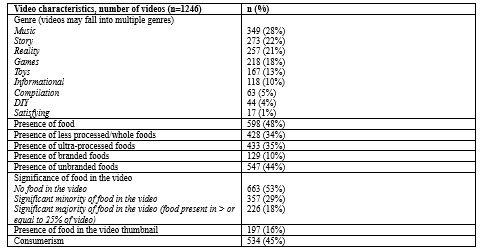General Pediatrics 1
Session: General Pediatrics 1
691 - Content Analysis of Food Items in YouTube Videos Viewed by Children
Friday, April 25, 2025
5:30pm - 7:45pm HST
Publication Number: 691.4307
Julie M. Zaituna, Oakland University William Beaumont School of Medicine, Grosse Pointe Woods, MI, United States; Tiffany Munzer, University of Michigan Medical School, Ann Arbor, MI, United States; Sarah Morris, University of Michigan Medical School, Ann Arbor, MI, United States; Jane Harness, University of Michigan Medical School, Ann Arbor, MI, United States; Megan H. Pesch, University of Michigan Medical School, Ann Arbor, MI, United States
- JZ
Julie M. Zaituna, DO, MPH
Clinical faculty
Oakland University William Beaumont School of Medicine
Grosse Pointe Woods, Michigan, United States
Presenting Author(s)
Background: Children have historically been a target of the food advertising industry because their preferences for certain foods are known to be shaped by food portrayals in digital media. In the most popular YouTube videos with child influencers, 90% featured ultra-processed and branded food products. Given the algorithmic specificity in YouTube, some children may be differentially exposed to more ultra-processed or branded food content; however, no studies have examined YouTube video characteristics or family characteristics associated with such food content.
Objective: To examine YouTube video characteristics and child and caregiver characteristics associated with greater exposures to ultra-processed or branded food and beverage content.
Design/Methods: We leveraged a subsample of data from the Common Sense Media “YouTube and Kids” study performed in 2020. Caregivers (n=154) of 2-8 year-olds submitted YouTube videos viewed by their children. We examined 1246 videos and coded for the presence of ultra-processed and branded foods (Table 1). Videos were previously classified by genre. Bivariable analyses examined video characteristics with presence of each food code. Multivariable analyses examined caregiver and child characteristics (caregiver age, education, race/ethnicity, income, child gender, child device ownership, siblings), with the presence of each food code. Analyses conducted in SAS 9.4.
Results: Demographic characteristics are shown in Table 2. Ultra-processed food content was present in 34% of videos, branded foods were present in 10% of videos. Presence of ultra-processed food content versus none was associated with greater median view counts (8.8 million vs. 3.5 million, p<.0001). Videos in the Reality (50% vs. 31%, p< .0001), Story (44% vs. 32%, p=.0004), and Toys (54% vs. 32%, p<.0001) genres were more likely to include ultra-processed food content versus all other videos. Videos in the Reality (27% vs. 6%, p<.0001) and Toys (24% vs. 8%, p<.0001) genres were more likely to contain branded food content versus all other videos. Presence of siblings in the home was associated with having viewed more videos with food content.
Conclusion(s): Ultra-processed and branded food content were prevalent in this sample of YouTube videos, particularly in the Reality and Toys genres. Future work should examine how YouTube videos might shape children’s immediate and long-term preferences for ultra-processed and branded food content. Policy makers should convene to reduce inadvertent branded food advertisements toward children in YouTube videos.
Table 1
.jpg) Food-based coding scheme.
Food-based coding scheme. Table 2
.jpg) Sample characteristics.
Sample characteristics. Table 3
 Video characteristics.
Video characteristics.
